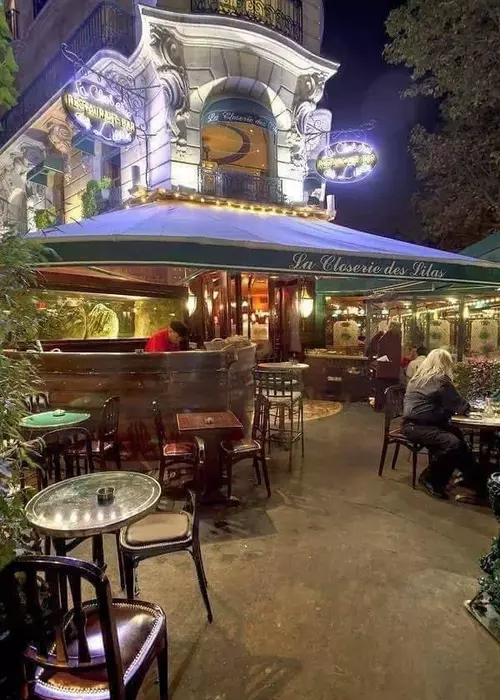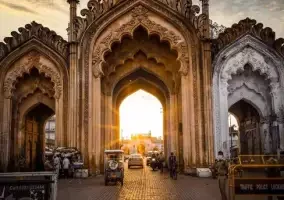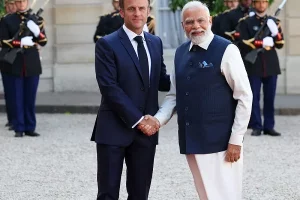This summer, as Paris emerges as one of the most popular travel destinations for well-heeled Indians, I have been time travelling to the French capital of the early 20th century– by rereading Hemingway’s A Moveable Feast. A memoir, this is an account of the author’s years in Paris between 1921 and 1926, when he was unknown and poor but met and socialised with a number of modern “greats”, from Scott Fitzgerald and James Joyce to Picasso and Gertrude Stein.
F. Scott Fitzgerald and Ernest Hemingway in Paris. pic.twitter.com/WN89OpT2HQ
— Honest Hemingway (@witandwisdom9) August 11, 2019
The Paris of those years, between the two World Wars, had emerged as the literary and artistic capital of not just Europe but the Western world. The city was vibrant with avant garde ideas and artists pursuing these. Years after the “Lost Generation”, as it was dubbed, was finally lost, the idea of writing works of fiction or poetry from a Parisian café, over sancerre and oysters, would still have remarkable appeal with many of the world’s literary minded.
But this column is not about the sense of romance Paris evokes. Nor is it about Parisian food– even though Hemingway describes it in sharp detail, mentioning what (and who) he encountered in the brasseries—white wine, potato salad, an elegant James Joyce with his family eating expensive meals et al—but also what he did not.
Gertrude Stein's home in Paris where Hemingway, F. Scott Fitzgerald, Picasso and others used to hang out pic.twitter.com/cjTAEY0yWq
— Thor Benson (@thor_benson) September 3, 2021
Hemingway’s most evocative descriptions of food are equally about its lack: “You got very hungry when you did not eat enough in Paris because all the bakery shops had such good things in the windows and people ate outside at tables on sidewalks so that you saw and smelled the food…The best place to go was the Luxembourg gardens where you saw and smelled nothing…There you could always go into the museum and all the paintings were sharpened and clearer and more beautiful if you were belly empty, hollow hungry. I learned to understand Cezanne much better when I was hungry”, he says.
Food, as also its lack, has clearly inspired art and literature all over the world. But is food itself an art?
Lately, it has become fashionable to dub chefs as artists, and restaurant food, as “culinary arts”. But this is usually a mistake because commercial food must pander to populism instead of an artist’s individuality and unique vision. Cooking then is mostly a craft—something requiring skill and practice even when there is controlled inventiveness.
However, it is possible to study the aesthetics of any culture’s food. Take the most popular dishes of a country’s cuisine and examine the cultural ideals and values these communicate. This is what food as a country’s soft power is about—a dispersal of this aesthetic to a wider audience.
If the Modernists in Paris were breaking away from conventions of the pre-war past, attempting new techniques such as stream of consciousness, cubism with its multiple perspectives or even the sharp, hard clarity of Hemingway’s prose, all of which would become very influential globally, food in Paris was keeping pace with change too.
The old style of French food with its peasant and some earlier aristocratic influences had conflated to give the food of the bourgeois in the city. But now, this was reformulated and elevated to haute cuisine in the years following the wars, by Escoffier, whose guide published in 1938 is still followed by culinary schools around the world, including those in India. This detailed a new system of organising the kitchen to produce several courses of refined and precisely-cooked dishes. Formal meals could run into as many as 17 courses, each matched with wine, but the dishes were not easy to cook. This elevated dining was made possible in fact by an emphasis on specialisation of skills, so that every component of a single dish was produced by a different specialist. A saucier to produce sauces, rotisseur for meats, pâtissier for pastry and desserts, and so on.
Good cuisine is the foundation of genuine happiness’ Auguste Escoffier. Executive Chef, John Williams MBE builds on the principles of Auguste Escoffier, making classic dishes relevant to today's diner, using the very best quality British produce. https://t.co/ezULuElXG7 pic.twitter.com/5nacqDdq7K
— The Ritz London (@theritzlondon) April 7, 2021
As haute cuisine became fashionable and aspired to—brought to America by social and arty influencers who had stayed, like Hemingway, in Paris for some years, home cooks sought to create dishes such as coq au vin or even chocolate soufflé and an entire industry attempting to teach them these sprung up via magazines, radio and TV. But this food was not easy to cook. As chefs internationally began to specialise in it, and restaurants offered it, attaching prestige to it (the Michelin guide came up in France, and as its prestige grew, so did French cuisine’s), French gastronomy was elevated to the status of one of the world’s greatest cuisines— aspired to by any one claiming sophistication well into the 1960s-1970s. Thus, aesthetic of “sophisticated” was successfully dispersed as an image of France on the back of haute cuisine. It abides even now, when chefs (and diners) have abandoned it in favour of lighter, simpler dishes.
Now, let us examine the aesthetic of Korean food, that is currently trendy, and how it is aiding the dispersal of Korean culture as more and more cooks and consumers on Instagram espouse bowls of bibimbap and tangpyeongchae.
Our New Website is Live! Follow the link in our Bio to browse our menu, check our plates and start your group reservation. #koreahouselongwoodfl #koreanfood #restaurant pic.twitter.com/rh2I2HtrDk
— Korea House Restaurant of Longwood FL (@koreahouserest) July 12, 2022
Even to someone not acquainted with Korea, the aesthetic of “harmonisation” can be evident, visually, in every colourful bowl of these dishes, where disparate elements of different colours have come together to make a cohesive dish.
In fact, there is a “Tangpyeong” policy from the mid-19th century, referring to a policy of political conciliation. The story goes that a king, concerned about strife between different political parties, invited representatives to friendly feasts and presented tangpyeongchae, made up of four different elements (mung bean jelly, shredded meat, dropwort and gim or seaweed) symbolic of how differences can be harmonised.
How food is presented can be a powerful visual symbol. We can all recognise the understated refinement, but extreme attention to detail and order as an aesthetic of Japanese cuisine. You don’t even have to taste the clean flavours of sushi or a bowl of cold soba, just look at images of the super expensive, and highly luxurious fruit that rich gourmets all over the world aspire to– from Sekai Ichi Apples washed in honey to watermelons grown in square moulds, to white jewel strawberries that look as if unripe but are very sweet!
In fact, if Japanese whisky is a coveted imported product all over the world having successfully challenged legacy Scotch businesses, it is also because of the aesthetic that accompanies it. The trendiest thing for a connoisseur these days would be to experience a highball in a Tokyo bar, where “Mizuwari” (“cut by water”, a way of drinking spirits with water) is elevated to an “art”.
So there's a Japanese Whiskey bar here in Little Tokyo named "Wolf and Crane"…
May have ordered a whiskey flight…
ヤバい pic.twitter.com/r9WdIvdHxi— Brendan Walker (@polyarc_brendan) June 30, 2022
Ice and water get reverence that few of us associate with these mundane ingredients. Water is made soft and lacking in minerals so as not to interfere with the taste of the whisky and three parts of water is added to one part of whisky. Ice is absolutely clear and low in oxygen to prevent melting faster. It is hand-chipped at these whisky and cocktail bars.
This “pure” aesthetic and extreme attention to detail is in fact now incredibly influential amongst bar communities in the world. And there are even fledgling start-ups even in India making specialised ice and water for whisky connoisseurs.
In sharp contrast to this understated orderliness, is the aesthetic of Iranian food, often described as “lyrical”, poetic and “ornate”. The typical flavour profile of Persian food—sweet, sour and savoury— and its emphasis on perfumery and colour conveys this aesthetic that we can see also in Persian design, carpets and craft. The association with flowers, fruit and nature motifs comes through in the food itself. In fact, a popular cookbook is called from the land of Nightingales and Roses.
Persian summer brunch!
Image via PersianGirlsUnited#PersianFood #weekend #IranStyle🍉 pic.twitter.com/08ybfUwxx6
— Iran Style (@Iran_Style) July 9, 2022
In India, Mughal food (and design and architecture), too placed a similar emphasis on idealised nature. The metaphor of the “garden”, an important theme in Mughal architecture, finds a resonance in creations such as Nargisi Kofte, which when cut into halves, are supposed to remind the diner of a pretty daffodil with its white and yellow, or elegant pulaos with names such as koku (cuckoo) and jasmine that Ghalib, the poet encountered in Lucknow and mentions in some of his non-poetic writing.
With their immense diversity, it is perhaps impossible to see regional Indian foods as reflecting a single aesthetic. Different climates, soils and people contribute to the range of Indian cuisines we partake of. But street foods like chaat or mithai now being refashioned by contemporary restaurant chefs and finding global recognition do reflect the idea of food to “give joy to the heart”, as entertainment with inherent playfulness and inventiveness.
It is perhaps pertinent that some of the earliest Indian recipes we can access (predating cook books in Europe) is from the Manasollasa, a 12th century Sanskrit text by the Chalukya king Somesvara III, with chapters on a range of subjects including music, dance, festivals and food—meant to give ullasa, or joy, as the name suggests.
Food has often been a celebration in India. This playfulness is perhaps the aesthetic modern Indian restaurant food now attempts to reflect.
(Anoothi Vishal is the author of Mrs LC's Table. She is also a columnist and food writer, specialising in cuisine history)




















